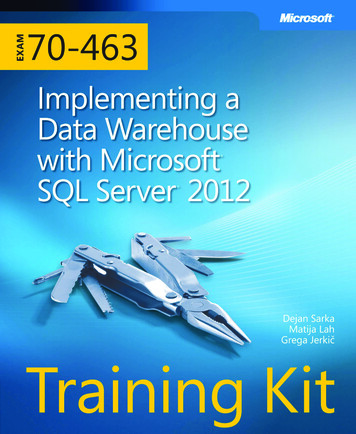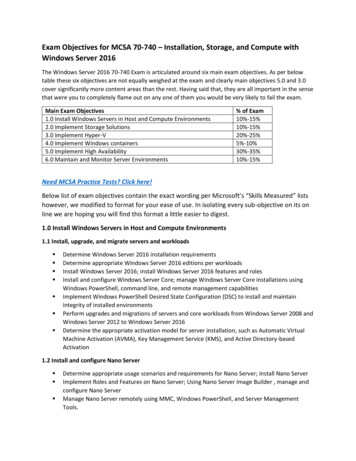
Transcription
WHITE PAPERHow to design and implementa cyber security strategyCritical Infrastructure SecurityGuide 2 Tait Limited 2016.
WHITE PAPERCRITICAL INFRASTRUCTURE SECURITY GUIDE 2 Tait Limited 2016.2
WHITE PAPERCRITICAL INFRASTRUCTURE SECURITY GUIDE 2Critical Infrastructure Security Guide 2:How to design and implement a cybersecurity strategyCyber security attacks are now real, present, and increasing in both their frequency andsophistication. While it is sometimes suggested that critical industries cannot risk interruptingoperations to retrofit appropriate security, governments are now determined to impose regulatorycontrols in order to protect national critical infrastructure.Faced with mandatory requirements to secure their industrial assets, communications networkoperators must be confident they have taken every precaution to protect their networks from attack.Each ICS is different and has unique requirements, so the complexity of security planning shouldnot be underestimated. Experienced security professionals are required at every stage, fromrequirements capture, to design, implementation, testing and beyond, including involving them inperiodic reviews and regular audits of all security policies, practices, management and reporting.This guide provides a general introduction into the processes and technologies of cyber security,specifically in relation to the communications that integrate an ICS. Its purpose is to help managersand decision makers to understand the cyber-security implications of existing and emergingcommunications technologies, and how organizations can begin the process of protecting theirassets from cyber-threats.In this paper, you will learn about: Where to start Knowing which regulations apply Seven strategies for network security Where to go for more informationThis guide should be read in conjunction withCritical Infrastructure Security Guide 1:What network operators need to understand about the cyber security threat Tait Limited 2016.3
WHITE PAPERCRITICAL INFRASTRUCTURE SECURITY GUIDE 2WHERE TO STARTFaced with all the threats and challenges described in the previous guide, where does an ICSoperator start? You can begin by becoming familiar with these three goals for your cyber securitychallenge: To define and protect your frontiers and reduce the attack surface. To install mechanisms to detect intrusion and mitigate its effect. To create a dynamic and evolving process that can keep pace with the appearance of newthreats.Because the threat landscape is perpetually changing, you will need to regularly update your ICSsecurity requirements, protection and monitoring measures. This is not a fit-and-forget exercise.The following is a general framework to break down the task into clear steps.Note that the process described here is not intended to replace specialist advice. We stronglyrecommend that you engage the services of a cyber security expert to ensure that your networkis secured. However, it is also important that you understand the steps that need to be taken, andthat you are well informed on the risks, threats and mitigation strategies available to you, so you arebetter equipped to work effectively in partnership with your chosen professional.12433Step 1: AssessDocument the security requirements for your ICS. These are largely driven by the standards andregulations that apply to your industry, as well as by the unique configuration of your ICS.You will need to Recognize which cybersecurity regulations and standards are applicable, identify all hardware, software and network components as well as all their interconnectionsthat can provide access, Locate all potential points of access, Determine all the legitimate users and applications and the access privileges they require,Step 2: PlanThere is no one-size-fits-all plan for making an ICS secure. Your ICS security assessment informs theproject plan and helps to identify the stakeholders and experts required for your project team.There will be a variety of options to consider for addressing the vulnerabilities identified by yourassessment. Each ICS has its own special requirements that are uncovered during the Assessmentphase. Professional expertise during the planning phase will prioritize which options to include inyour plan.However, it is possible to outline some strategies that operators typically use to mitigate thevulnerabilities of an ICS. Tait Limited 2016.4
WHITE PAPERCRITICAL INFRASTRUCTURE SECURITY GUIDE 2 Equipment replacement plan (removing components that cannot be secured). Change management plan for firmware, software, and OS patches/upgrades or reconfigurations. Network segmentation plan (firewalls, secure architecture, locking down unused ports, deploying ‘data diodes’ where one-way communications is sufficient). Application whitelisting to block access and execution of unknown applications. Encryption of transmissions. Monitoring and limiting remote accesses. Authentication plan, including multi-factor authentication, strict access control Response and recovery plan which describes responses to specific threats and how to recoverfrom them. Test plan, including penetration testing.While not strictly a cyber security issue, you will also need a physical security plan for securingequipment and premises. This helps prevent direct attacks on your network, via malicious oraccidental intrusion from equipment and devices such as smartphones, laptops, USBs etc.Step 3: DeployImplement your ICS security plan, tackling the most urgent vulnerabilities first — the most commonthreats which could cause the most severe damage. Prioritizing vulnerabilities and threats can helpto create a phased deployment plan.Securing an industrial control system inevitably involves disrupting its 24/7 operations. Regulatorsand all levels of internal management must buy into the deployment project and compromise onpolicies and penalties that will cause any disruption. It is a matter of cost versus risk. Ensure thatyou have included trials of all your security procedures and your training plan before going live.Increasingly, national and regional regulators are requiring mandatory compliance with securitystandards and certification under compliance programs. However, they are also a valuable source ofadvice and support on how to move from plans to deployment.Step 4: Monitor and LogIt’s not a matter of if, but when a cyber security breach will occur. The one assumption you cansafely make is that your network is not safe. You can expect to suffer a breach of security andshould therefore have your response prepared in advance. Even with the best processes, tools anddedicated security personnel, a new form attack can get through.A good starting point is to collect, store and regularly report data on all unexpected traffic orunusual accesses across your ICS, and keep histories so you can spot trends in security breaches.And while it may seem obvious, a vital aspect of mitigation is to avoid repeating the same mistakes— careful examination of the audit logs can be useful to establish what happened.To ensure the best possible outcome, many organizations maintain a Computer Security IncidentResponse Team (CSIRT), trained to respond quickly and effectively to Cyber security incidents. Theteam is not usually responsible for detecting incidents — their role is to ensure that the responseis coordinated to mitigate harm to the greatest degree possible. Your CSIRT needs a tested andregularly exercised response and recovery plan that describes and documents procedures forresponding to an attack.This might include: wholesale password resets, shutting down parts of the ICS network, running deep virus and malware checks.A recovery plan should include regular backups of critical data that can be used to restore some orall of the ICS operation as quickly as possibleSecurity specialists can use a variety of tools such as Intrusion Detection and Prevention Systems todetect and identify intrusions, log and report to the ICS operators, and even to prevent the intrusionfrom causing any real damage. However, such tools can also be analyzed by hackers looking forways of avoiding detection, so you cannot rely exclusively on technology to detect an attack. Tait Limited 2016.5
WHITE PAPERCRITICAL INFRASTRUCTURE SECURITY GUIDE 2KNOWING WHICH REGULATIONS AND STANDARDS APPLYEvery industry sector has its own specific security threats and most often, is subject to mandatoryrequirements with governmental or other regulatory oversight. Regulatory bodies create industryguidelines and standards.For example, the United States electrical utility sector is regulated by the Federal Energy RegulatoryCommission (FERC) and North American Reliability Corporation (NERC). NERC has created specificregulations designed to protect against attacks that might compromise the bulk electrical system.They also publish important guidelines and suggested implementation notes that will be a valuableresource.Most governments now regulate Critical Infrastructure Protection (CIP), including cyber security.These govern the infrastructure — energy, water, communications, etc — that are critical to theeconomy and society.Globally, two closely-related groups of high-level standards have key bearing on CIP and theassociated industries: ISO27000 is a process framework from the International Organization for Standardization foroperational security management. It is comprehensive and defines sector-specific guidelines.For example, ISO27032 provides guidelines for Cyber Security. (Standards and guidelinesderived from ISO27000 are used throughout Europe.) NIST SP 800 focuses on computer/cyber/IT security guidelines, recommendations and references from the US National Institute of Standards and Technology. NIST SP 800 is now widelyused as the basis for other industry-specific recommendations. For example, NERC reliesheavily on NIST SP 800 to create the NERC CIP version 5 regulations for the North AmericanBulk Electrical Supply industry.“.in conducting hundredsof vulnerability assessmentsin the private sector, in nocase have we ever foundthe operations network,the SCADA system, orenergy managementsystem separated from theenterprise network.”Within the US, eight regional entities have delegated authority from NERC. (An example is WECC,the regional entity for the Western interconnect.) Regional entities coordinate and supportinterconnection members, most of which have active Cyber Security programs and can provideadditional advice. In particular, the regional entities create Inherent Risk Assessment (IRA) reviewsto provide a professional assessment and security compliance process for utilities1.Regional authorities also maintain resource centers on their web sites, containing informativeindustry discussions and forums. Tait Limited 2016.6
WHITE PAPERCRITICAL INFRASTRUCTURE SECURITY GUIDE 2SEVEN STRATEGIES FOR NETWORK SECURITYHere are the most commonly-used security strategies that operators should consider as part of theirsecurity portfolio.1. Isolating networks and trafficIsolating traffic is a good way to deliver better Cyber Security outcomes. Internet connectionsharing connects multiple LAN computers to the Internet through a single connection and a singleIP address. Clearly, this represents a security risk, which must be mitigated. ICS traffic profiles andtypes — and the need for predictable, real-time performance — differ from normal corporate traffic.By definition corporate networks are normally attached to the internet. ICS systems should not be.The two should be separated, normally with industry-proven firewall technology.This involves carefully defining rules for all traffic that is allowed to flow across your border. Accessis restricted to users who genuinely require it — and who can prove they are who they say they are.Isolation also applies to the type of traffic on the ICS network, restricting or removing traffic such asFTP, email and remote access. In fact, a serious risk analysis should be undertaken before allowingany new traffic on an ICS network.Given that connections to the corporate network provide the greatest source of malicious codeintrusions, it would seem obvious that severing ties to the corporate network would dramaticallyreduce ICS infections. Many ICS operators believe that they have no direct connections tothe Internet and have successfully isolated their ICS from Internet hacks. However, as the USDepartment of Homeland Security reported2 :“In our experience in conducting hundreds of vulnerability assessments in the private sector, in nocase have we ever found the operations network, the SCADA system, or energy management systemseparated from the enterprise network. On average, we see 11 direct connections between thosenetworks. In some extreme cases, we have identified up to 250 connections between the actualproducing network and the enterprise network.”Risks from mixing ICS traffic with corporate traffic include: Wider base of potential attacksSince authorized users (and unauthorized users who maliciously gain access to the corporatenetwork) can attack or monitor ICS systems. Denial of Service (DOS) attacksThis may be mounted from individual or groups of corporate workstations, without theknowledge of legitimate users who may have unwittingly loaded malicious code. It can beremotely triggered, and can occur at the interface from the node to the enterprise. Jammersdisrupt consoles on the wide area network, and linking at the RF physical layer. Unauthorized monitoring of ICS trafficMonitoring traffic does not cause immediate damage but it can provide system information toan attacker who is then better able to mount an attack. Man-in-the-middle attacksBy tapping into a communications link, hackers can hijack a session between authorized usersor systems, enabling them to capture sensitive data which they can use to impersonate thecommunicating parties. Readings that are meant to go to monitoring stations can be deleted,diverted or modified, false commands can be send to operators, or data transmissions can bereplayed causing network disruptions.This is by no means an exhaustive list but underscores the reason why ICS traffic should be isolatedfrom corporate traffic and be tightly controlled. Regularly testing border crossing points helps toensure security systems are performing as expected.In reality, it is practically impossible to fully isolate networks. By necessity, traffic is mixed, as IPphone systems, IP consoles, workforce management, location services and SCADA applications areintegrated. Current approaches to separating traffic include: MPLS (multi-protocol label switching) to separate traffic based on packet labelling, Carrier Ethernet based on MetroEthernet technology connecting subscribers and operators toa metropolitan WAN. Tait Limited 2016.7
WHITE PAPERCRITICAL INFRASTRUCTURE SECURITY GUIDE 22. Network segmentationAnother way to achieve better isolation is to break a large network into smaller subnetworks whichact as operational zones, each with its own security requirements. To move from zone to zone a useror application must satisfy the security requirements of each zone.Network segmentation, properly implemented, will limit free access across the network and canrestrict the damage caused by a malicious intruder to the zone level. Your consultant or specialistcan provide information and advice here.3. FirewallingFirewalls prevent unauthorized users — usually from the internet — from accessing privatenetworks. Every ICS network will contain some open ports, and firewalls provide a level of protectionfor these. Messages entering or leaving the internet must pass through one or more firewalls, whichexamine each message and block those that do not conform to security criteria. However, firewallsare only truly effective when you have excellent knowledge of your core network elements and canmap them to flows of data you will allow or block. Network components should be fully documentedin a current, continuously-maintained network plan.There are several types of firewall technology (and many protocols) and you should seek expertadvice on choosing the right one. For example, ‘stateful inspection’ firewalls, joined through a secureportion of the network called a ‘demilitarized zone’ (DMZ) or ‘perimeter network’, can provide thehigh degree of isolation required. They perform dynamic packet filtering, checking packets to see ifthese are coming from the right connection rather than through a back door.While segregating traffic can improve overall performance, this is more complex than deployingsimple enterprise firewalls. Careful design will ensure that complexity does not result in delays orconfusing configuration. In fact, firewalls should be the only dual-homed devices — simultaneouslyattached to two networks on the network.Some sites pair two firewalls from different manufacturers, to further reduce the effect ofcompromise. There are many possibilities, including more layers of DMZ but excessive complexityshould be avoided as it can lead to confusion. The firewalls and DMZ combination will: isolate traffic and segregate users, enforce secure authorization of all ICS users according to the organization’s policy (whichshould be regularly reviewed), enforce end-point ICS security where users only gain access to devices they are authorized for. Tait Limited 2016.8
WHITE PAPERCRITICAL INFRASTRUCTURE SECURITY GUIDE 2The diagram from NIST SP800-82 illustrates a general configuration for reasonable securityand performance. Each customer solution needs to be designed to meet specific needs. Firewallconfiguration is beyond the scope of this document but should be carried out by an expert in boththe equipment and the specific network. A useful starting point is “deny all” as a baseline, and toonly allow traffic once it has been assessed for risk.It is somewhat alarming to discover that many companies simply use the default configurationprovided by the firewall supplier. As a result, a 2004 survey of 37 company firewalls3 found that: nearly 80% allowed “Any” services on inbound rules as well as unsecured access to the firewallsand the DMZ roughly 70% permitted devices outside the network perimeter to access and manage thefirewallWhat sort of traffic commonly travel across an ICS firewall and what risks do they pose? Firewallconfiguration should screen all traffic, block undesired traffic, and allow the rest only underparticular circumstances.Common firewall protocolsThe following list gives some general guidance on common firewall protocols.DNS (Domain Name System)DNS converts domain addresses into real IP addresses. It is fundamental to the Internet but isnormally not required to transition across the DMZ in either direction.NATNetwork Address Translation is required by IPv4 to minimize consumption of IP domains. It remapsinternal domains to single external IP addresses and is very widely used, as IPv4 address spacebecomes exhausted.Without NAT, internal networks may not be able to communicate, but its use should be carefullycontrolled and domain mapping well documented. Some protocols, such as those requiring directaddressing, are broken by NAT and may require special tunneling modes. Consult a firewall specialistor vendor on the use of NAT, particularly with multicast traffic, to avoid unintended consequencesfrom forwarded packets.Although NAT is not required by IPv6 (which has no shortage of addresses), it may be needed toconnect IPv4 and IPv6 networks.HTTPHTTP is the core protocol for web browsing, along with its secured version HTTPS. Base HTTPhas no inherent security and should not be used to cross from a corporate network into theICS. However, it is increasingly used to configure devices through embedded web servers, soit is essential to secure it as thoroughly as possible (such as only allowing HTTPS) and only tonominated devices. Some firewalls block scripts and Java, both common attack vectors carried byHTTP.For example, Tait base stations use embedded web servers for remote access to networkmanagement. A digital certificate/key pair provides secured HTTPS access. (The key is encryptedwhile the certificate authenticates the key.) For maximum security, a certificate is generated andsigned by an external authority trusted by the browser.By default, the base station generates its own self-signed certificate. This allows traffic to beencrypted, but does not provide authentication. The browser displays a warning when connecting tothe Web UI.You can upload a certificate generated by a trusted authority. For a public network, the certificatemay be obtained from a commercial provider. For a private network, it may be generated by thenetwork’s own certificate authority, and the certificate added to each browser’s list of trustedauthorities. Tait Limited 2016.9
WHITE PAPERCRITICAL INFRASTRUCTURE SECURITY GUIDE 2SNMPSNMP is widely used to monitor and control devices remotely, and to send alerts. Most routine trafficis the result of periodic polls from a central Network Management System, which cause devices tosend a structured message in response. SNMPv3 has limited security but earlier versions have nosecurity and can potentially completely reset or reconfigure devices. (SNMP v3 uses SHA-1 andAES128 encryption and provides encryption and authentication in both directions.)To balance useful functionality with the significant risk it poses, restrict SNMP to nominated stationsand only between the DMZ and ICS; there should be no need for SNMP traffic from the corporatenetwork; consider disabling SNMP unless it is specifically required.DNP3Critical for most SCADA applications, it originally had weak inherent security making it vulnerable toman-in-the-middle and spoofing attacks. An attacker could easily pose as, or control any device.However installations may have a mixture of systems, so ideally, DNP3 should not be allowed pastthe DMZ. No DNP3 traffic should be accepted from the corporate network unless it is a requirementof the system architecture. Newer versions support IEC 62351-5, which provides authentication forIEC 60870-5/6 (SCADA)FTP and TFTPThese file transfer protocols are convenient, but have little or no security so they pose a significantthreat. If possible they should be prevented from crossing the DMZ.There are some secured versions but they are not widely deployed and unless operated within aVPN tunnel, they should be used with care. Careful design is needed for any system that relies onFTP or TFTP and it is preferable to block these.PING and ICMPPING is useful to determine presence but that alone may be enough to compromise security so youshould give very careful consideration to whether PING should be supported. Many systems do notallow it and disable ICMP echo and timestamp, especially on broadcast or multicast addresses.TelnetThis older protocol provides remote terminal access to devices, similar to the DOS command line.A common attack vector, it is not secured and should be not allowed to transition the DMZ withoutbeing enclosed in a secured tunnel and linked with strong authentication to specific devices.SMTPA simple email transfer protocol, SMTP is widely deployed and is a common source of attacks. Manydevices within a ICS will use it to send automated messages to control systems. The safest optionis to prevent SMTP crossing the DMZ in either direction, but it is possible to secure outbound-only(such as ICS-to-corporate) with care.DCOMDCOM is a Microsoft protocol often used for Process Control through Remote Procedure Calls(RPC). Even when fully patched, RPC is probably the most common attack vector. Under nocircumstances should it be allowed to originate from the corporate network, and only allowedbetween the ICS and the DMZ with care and understanding about what it is doing. DCOM is thesource of much pain.4. Why ‘Air Gapping’ is not enough‘Air gapping’ refers to physically isolating the ICS control network from unsecured networks suchas the Internet or a corporate LAN, so that there is a physical gap between them. The devices onone side of the gap cannot communicate with devices on the other side. Based on the assumptionthat threats mainly come from outside the ICS, this was considered an adequate security measure.Although external threats certainly receive more attention, some statistics suggest that cybersecurity may be more threatened from within, occurring while detection mechanisms are busy withoutside threats. Internal threats are a significant problem.While we commonly characterize internal threats as malicious, an internal attack is most likelyto be accidental or opportunistic. Many employees can access your systems and network, plus Tait Limited 2016.10
WHITE PAPERCRITICAL INFRASTRUCTURE SECURITY GUIDE 2contractors, third-party support and service providers: you are likely to have cloud-based IT serviceswith administration platforms that are not visible to your organization.Identifying and mitigating internal threats involves seemingly-endless combinations and degrees ofexpertise, motivation and access specific to each individual. An expert advisor can tailor securitysolutions based on risk.Apart from technical solutions, five strategies deserve mention: Provide security access by role to increase visibility of individuals. Enforce strong authentication policies to ensure users are who they say they are. Separate duties and responsibilities to reduce opportunity for collusion or false accusation,which can prove costly. Regularly analyze logged data to identify irregularities such as repeated access to files. Organizations typically use data forensically, but it has greater value when analyzed to identifypotential attacks. Assign specific individuals to search for and identify vulnerabilities — systems, processes andpeople not acting “normally” should trigger closer observation.5. Controlling access: The human factorWhatever the system, and however carefully it is designed, it will still require access by people withinyour organization, opening up potential vulnerabilities.Your access method should follow a documented process, driven by regulatory needs appropriate toyour industry and informed by your expert risk analysis. It is hard to generalize, given each systemhas its own characteristics, so you should seek expert advice.ComplexityComplex systems are hard to understand, so people may try to work around processes that restricttheir ability to do their job. Every process should be carefully examined to see if can be simplifiedwithout compromising the outcomes. Employees should be involved in the process and encouragedto contribute towards its design.PortsPeople will access the ICS elements from computers. Each computer, and the ICS elements theyconnect to, responds to access requests through IP ports. These allow access to specific functionswithin a common IP address. For example, a device will have a single IP address but packets sentto its 80 port will be directed to an embedded web server. The catch is that devices can respond tomany different ports and only a few of these may be documented. These ‘open ports’ represent athreat since they provide access to functions which may not be well protected. It is best practice todisable all unused ports.“ each system has itsown characteristics, soyou should seek expertadvice.”Port scanning is the most basic way to look for open ports in a device, which is precisely howvulnerabilities are exploited. By incrementing the port number, responses can give vital clues aboutthe software and structure of the device being targeted.Defined points of contact with corporate networks should be through a DMZ (perimeter network)which is ithen isolated using firewalls. Servers that support ICS functions should be located on thisDMZ and access restricted to specific individuals through robust, regularly changed passwords.Access to the DMZ must be logged to a separate device which not part of the firewall.Obviously, each network’s architecture and security requirements are different, and expert advice isneeded. A recommended source of advice on ICS architecture strategies has been developed by theDHS in the Control Systems Security Program (CSSP). NIST SP 800-41, Guidelines on Firewalls andFirewall Policy provides general guidance for the selection of firewalls and the firewall policies.User access controlUser level access control is as important as network level access control.Every intruder’s target is to gain access at the highest security level. Shared user accounts andweak passwords are common targets, so root or super-user accounts must be protected with strongpasswords. Users should not use root or administrator accounts for day-to-day activities. Tait Limited 2016.11
WHITE PAPERCRITICAL INFRASTRUCTURE SECURITY GUIDE 2Access levelsUsername/passwords provide basic access security combined with access levels. Passwords needto follow best practice rules established by the corporate IT department and access levels rigidlyenforced: users should only be able to access equipment they are authorized for. Logging access toseparate, secured servers is considered best practice but you should consult an expert to ensurethese systems provide the levels of protection needed.For example, Tait systems provide three access levels:UserDescriptionAdministratorAccess to all pages of the Web User Interface; carry out allfunctionAccess all pages of the Web User Interface except.Tools User AdminMaintainerGuestDisabledAccess to ‘Monitor’ onlyNot permitted to log in or carry out any functionsSpecific users are allocated to these categories through access tables through LDAP (LightweightDirectory Access Protocol) or RADIUS (Remote Authentication Dial-In User Service). When a userattempts to log in, the base station authenticates them using the LDAP directory to determine ifthey match one of the access rule
Commission (FERC) and North American Reliability Corporation (NERC). NERC has created specific regulations designed to protect against attacks that might compromise the bulk electrical system. . ISO27032 provides guidelines for Cyber Security. (Standards and guidelines derived from ISO27000 are used throughout Europe.) NIST SP 800 focuses .










